In the Eastern European countries of Ukraine, Belarus and Russia, they are a well-known fresh-delicious snack and have been very popular since the early Middle Ages - fermented apples. During the Soviet period they were mass produced and popularized for sale. After the collapse of the USSR, when previously unknown imported dishes and products appeared in the post-Soviet space, industrial production was stopped. Since then, this snack is again prepared mainly at home in small quantities.
Contemporary preparation
In the 21st Century, as with so many traditional dishes, every family has their own secret recipe. Nevertheless, two essential methods of preparation can be distinguished. They differ regionally in the ingredients used and the fermentation vessels.
In Ukraine, the still sour harvested fruits are fermented in oak barrels in which wheat straw and cherry leaves are placed on the ground. The apples form a second layer, which in turn is covered with straw. Then comes another layer of apples, and so on. When the barrel is full, the contents are filled with a salt brine, some honey and cinnamon, covered with a linen cloth and a wooden board and weighed down.
In Russia and Belarus, straw is dispensed with and rye flour, malt, sourdough and some peppermint is added to the ferment. Fermentation is often carried out in enamel trays.
By the way, the division into regions is not necessarily strict, so you can encounter fermented apples with sourdough even in Ukraine in winter. Anyway, if you are offered a fermented apple, I strongly suggest: Go for it!
Wikipedia offers a good article about the history of fermented apples. It is written in Ukrainian, but can also be understood quite well in English with Google Translate. https://uk.m.wikipedia.org/wiki/Квашені_яблука
By the way, apples in Eastern Europe are not only popular as a pure, fermented snack. Sauerkraut is also preferably fermented together with apples and carrots in this region. And that tastes delicious!
What do fermented apples taste like?
In the fermentation process of fruit, part of the sugar is converted into lactic acid (0.5-1.5%) and alcohol (0.8% to a maximum of 3%) under the influence of lactic acid bacteria and yeasts. As a result, fermented fruits taste refreshingly sweet and sour and have a very long shelf life.
Make your own malted rye flour
To make malt, first let rye grains germinate until they get small tails. This takes approx. 1-2 days.
Then they are dried at 50°C in the oven or in the dehydrator. With me they are done after approx. 3 hours in the oven. Then you grind them into flour, which can be done with a grain mill or in a mortar.
If you make a lot of malted flour at once, it is best to store it dark in the refrigerator. This preserves the B vitamins.
What is the shelf life of fermented apples?
The apples have a very long shelf life due to fermentation. Of course, it is important to always remove them with clean tools and ensure that the remaining apples stay covered with brine in the vessel. I find this difficult because the apples have so much buoyancy. That's why I categorized the recipe as suitable for advanced fermenters. Most of the time they are pirated and snacked away from me anyway.
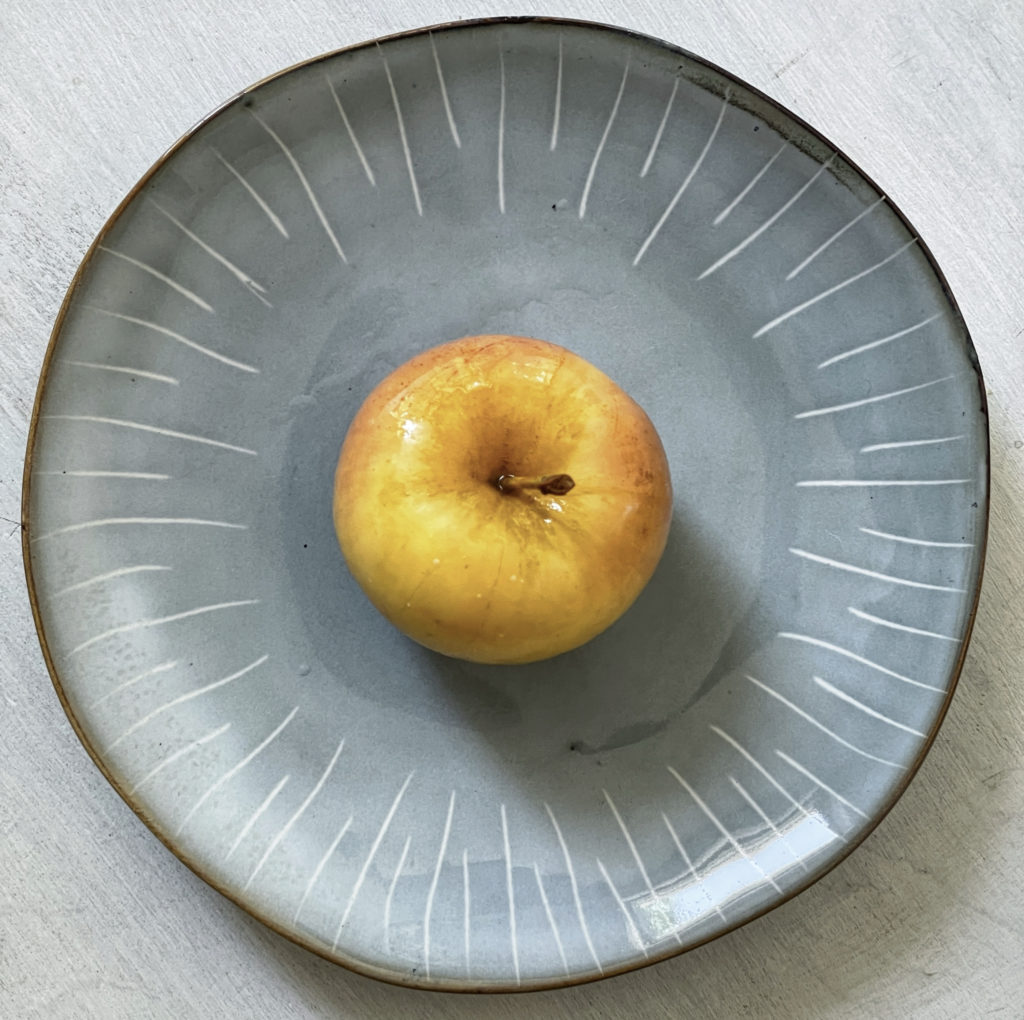

Fermented apples are a zero waste product
Finally, I have a great tip if you like baking. The brine of fermented apples is full of active bacteria that provide your sourdough just the right food. I recently fed a rye sourdough with it, which became very active and had a delicious aroma.
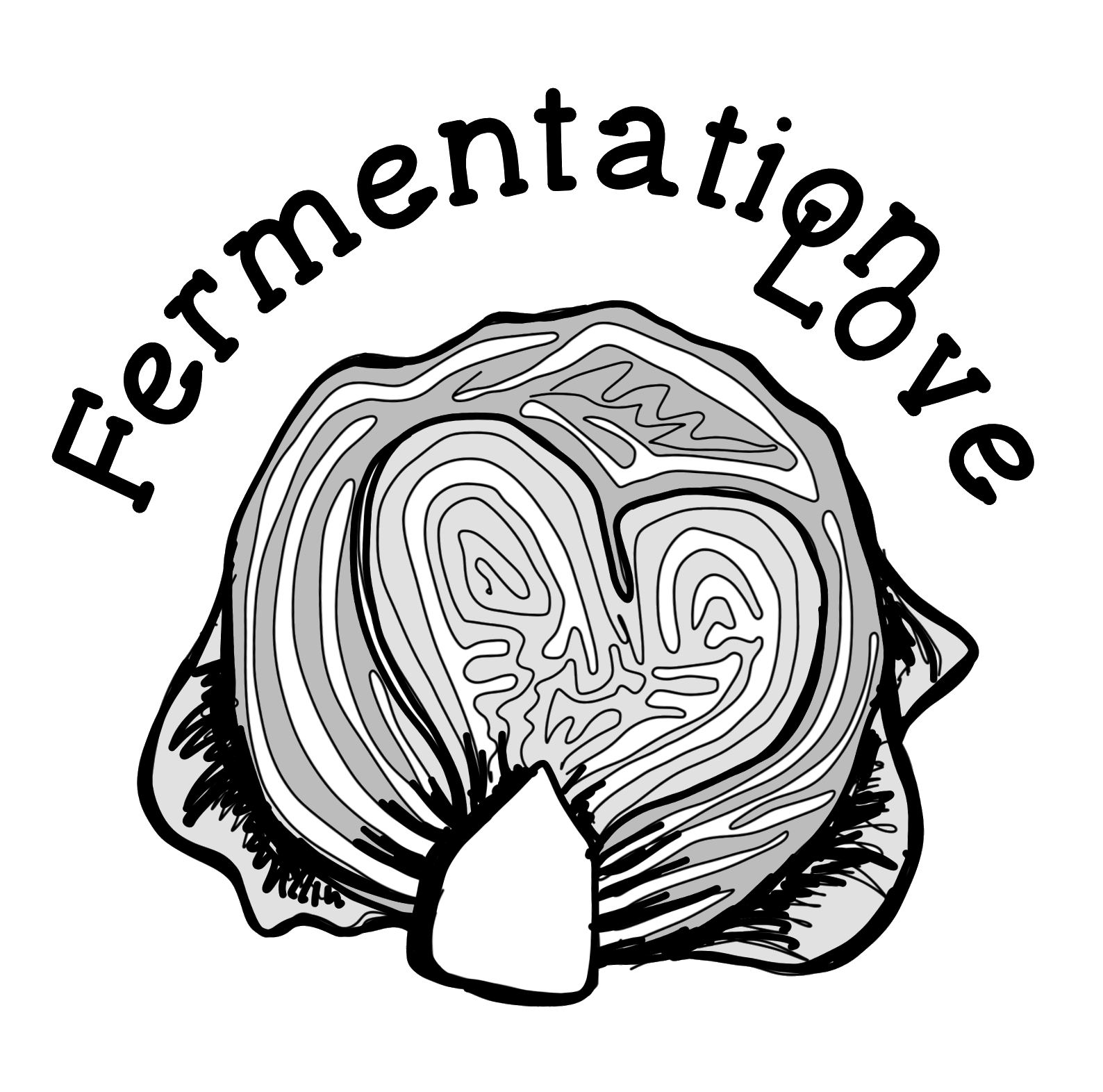
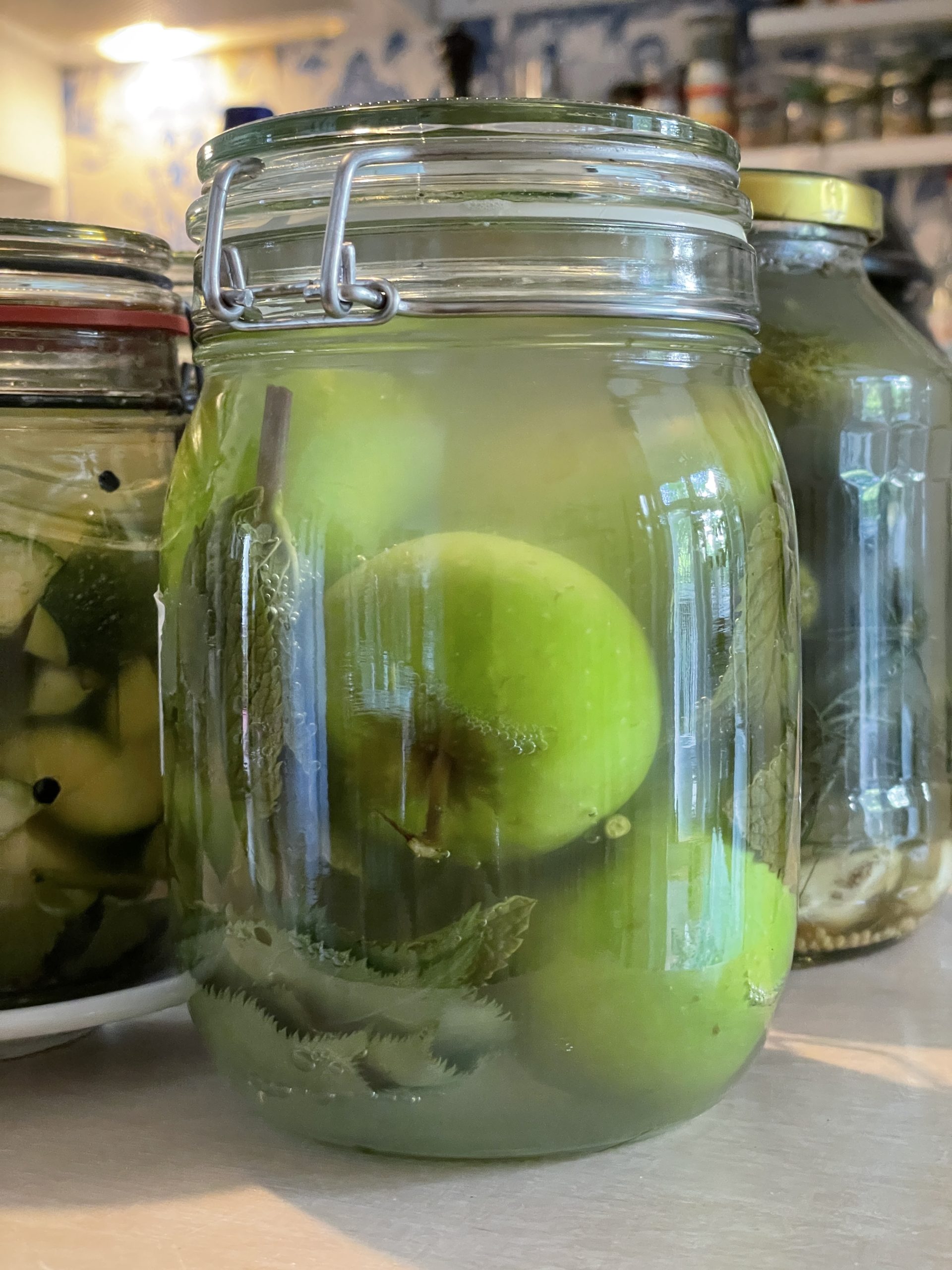
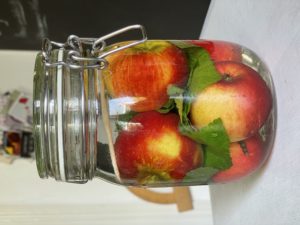
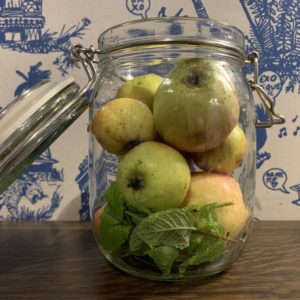
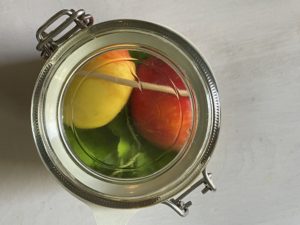
I am curious if the currant leaves could be substituted with something else if currant is not available (like fig leaves?); do you have a suggestion? Thanks!
Hej Jack,
yes, absolutely!
You can replace them with any other leaves rich in tannin, like cherry, wine, laurel or oak. With oak you have to be sure which tree you take it from, though – Quercus rubra and Quercus palustris Münchh. are not recommended. If you’re located in Northern America, you should probably just go with any other leaves.
I have not tried fig leaves myself yet, but I assume they would also work.
Happy fermenting!
Katsu
Thank you so much! I’m very excited to try this new-to-me ferment!
Liebe Katsu,
ein tolles Rezept, was ich gleich ausprobieren werde. Bildet sich bei der Fermentation kein Alkohol?
Liebe Grüße
Ines
Hej Ines,
ein wenig Alkohol kann sich hier bilden, es werden ja wilde Hefen transformiert. Das Ergebnis habe ich gustatorisch jedoch noch nie als alkoholisch wahrgenommen.
Lass es Dir schmecken!
Katsu
Hallo Katsu,
müssen die Äpfel irgendwie vorbereitet werden?
Müssen da z. B. mit einem Zahnstocher oder Ähnlichem einige Löcher rein gestochen werden? Müssen die Äpfel supergründlich gewaschen werden oder eher nicht? Ist es in Ordnung, wenn ich nur Pfefferminzblätter nehme und zum Schluss; funktioniert das ganze, auch wenn ich den Zucker weglasse? Halt so wie beim Sauerkraut oder milchsauer eingelegtem Gemüse.
Gruß
Wolfgang
Hej Wolfgang,
die Minze kannst Du weglassen, die Johannisbeerblätter nicht. Die Äpfel werden nicht angestochen, sonst hätte ich das ja im Rezept angegeben. Würde wahrscheinlich auch zu weich werden dann. Und wenn Du den Zucker weglässt, ist es ein anderes Ferment. Das kannst Du gerne ausprobieren. Ich mag meine Äpfel so fermentiert, wie ich es aufgeschrieben habe.
Gutes Gelingen,
Katsu
Danke für die schnelle Antwort.
Dann muss ich mal nachsehen, ob ich noch ein paar Blätter finde.
Den Zucker würde ich gerne weglassen, weil ich Diabetiker bin.
Ich versuche dann halt mal zwei Sorten, eine mit süßen Äpfeln ohne Zucker und die säuerlichen Äpfel mit Zucker.
Hej Wolfgang,
Du kannst auch andere tanninhaltige Blätter nehmen, wie Kirsche oder Feige. Auch Lorbeer geht, bringt jedoch den typischen Eigengeschmack mit.
Der Zucker wird im Fermentationsprozess umgewandelt. Ich kenne mich mit Diabetes nicht aus, aber wenn Du die Antwort Deines Körpers messen kannst, kannst Du die Unterschiede feststellen?
Gutes Gelingen und bleib gesund!
Katsu
Hi Katsu
Ich finde du hast eine richtig tolle Seite, das Rezept mit den Äpfeln hab ich gleich ausprobiert. Danke!
Hast du mit Dattelzucker auch schon fermentiert? Ist das auch möglich?
Liebe Grüße Christina
Hej Christina,
danke, das freut mich! Dattelzucker habe ich nicht im Haus, aber wenn Du es ausprobierst, berichte gerne, ob es funktioniert.
Gutes Gelingen!
Katsu
Hi, ich habe ebenfalls die Äpfel fermentiert. Für was sind die Blätter der Johannisbeere, bzw. was geschieht mit den Blättern während der Fermentation?
Es bildet sich bei mir eine Art Niederschlag im Glas aus.. hmm
Bin mal gespannt wie die Äpfel schmecken werden..
Gr Th
Hej Thomas,
die Gerbstoffe der Blätter sorgen dafür, dass die Knackigkeit erhalten bleibt und man keinen Matsch produziert. Einen minimalen Geschmackseffekt haben sie auch.
Ich hoffe, das Ferment schmeckt Dir am Ende so gut, wie mir!
Gutes Gelingen,
Katsu
hei und Danke für das tolle Rezept! Die gerbstoffe dürften auch in getrockneten Weinbl¨ttern erhalten sein. Denkst Du diese kann man auch verwenden, wenn es an frischen Blättern mangelt? Danke! Frohe Weihnachten!
Hej Dirk,
ja, das geht klar. Schwarzer Tee würde auch gehen, bringt jedoch viel Eigengeschmack mit. Gutes Gelingen!
Katsu
Liebe Katsu,
vielen Dank für deine inspirierenden Rezepte!
Eine Frage zu den Johannisblättern: meinst du es funktionieren auch getrocknete?
Ich will das unbedingt ausprobieren, komme aber nur an getrocknete Blätter.
Viele Grüße!
Hej Claudia,
ja, das geht auf jeden Fall. Schwarzer Tee würde auch gehen, bringt jedoch auch den Eigengeschmack mit.
Gutes Gelingen!
Katsu
Toll! Danke dir!
Hallo Katsu,
Deine Rezepte haben mich neugierig gemacht. Da ich im Garten Tannen mit frischen jungen Triebspitzen habe, überlege ich, ob sie sich auch eignen. Habe sonst nur Blätter von Apfelbaum, Reneklodenbaum und Erdbeerpflanzen, Holunderbusch, Hagebutten, Rosen, Mahonie, Ahorn, Birke und ein junger Strauch Aronie oder Heidelbeere. Und jede Menge Giersch, Löwenzahn, Zitronenmelisse. Bin noch Gartenneuling mit altem Garten voller unbekannter Überraschungen.
Wünsche dir viele weitere interessante Ideen und viel Freude am Entwickeln.
Habe viel Lust, deine Rezepte auszuprobieren und ernte gleich ein paar Winteräpfel.
Hej Anka.
Junge Triebspitzen sind fabelhaft. Probiere sie im Sauerkraut oder in einer scharfen Sauce. Klasse Auswahl an Kräutern hast du da, damit kannst du viele Experimente machen. Ich mache gerne schlichtes Kraut mit neuen Zutaten, da lerne ich den Geschmack am besten kennen. Tanninhaltig ist jedoch nichts davon.
Viel Spaß beim Fermentieren,
Katsu
Liebe Katsu!
Ich habe soeben meine fermentierten Äpfel probiert und bin etwas erschrocken…es bitzelt ziemlich auf der Zunge. Beim Öffnen des Glases roch es auch ordentlich nach Alkohol, so wie es einmal roch, als ich meinen Sauerteig wegen spontan verlängerter Ferien vernachlässigte.
Meine Frage: ist ˋnur´ der Geschmack etwas zu heftig geraten oder eventuell auch der Alkoholgehalt? Kann ich sie trotzdem essen oder könnte was bedenklich schief gelaufen sein?
Mein Verdacht ist, dass ich sie zu lange habe fermentieren lassen, das waren jetzt 8 Wochen bei ca. 20 Grad und dann noch 2 -3 Wochen bei ca. 14 Grad…?
Vielen Dank im Voraus für deine Hilfe🙏!!
Maxie
Hej Maxie,
der Fruchtzucker wird von den Hefen und Bakterien in Milchsäure, Alkohol und CO2 umgewandelt. Was Du da erlebst, ist also möglich und kein Fehler. Wenn Dir das Pritzeln nicht gefällt, kannst Du es rausrühren oder länger fermentieren lassen. Und wenn es Dir zu alkoholisch schmeckt, lass das nächste Mal den Sauerteig und das Mehl weg.
Jetzt kannst Du aus den Äpfeln Kompott kochen, das verringert sowohl Pritzeln, als auch den alkoholischen Geschmack.
Bon appétit!
Katsu
Vielen Dank für die schnelle Antwort! Ich schau mal, was ich damit mach, vielleicht gewöhnen wir uns ja ans Bitzeln und sonst ist Kompott ja ein super Plan B.
Hallo,
kann ich denn den Sauerteig auch weglassen? Vg
Hej Sissi,
genau, optional bedeutet, dass du selbst entscheiden kannst, ob du diese Zutaten benutzen möchtest. Ich mag es lieber ohne Sauerteig.
Gutes Gelingen,
Katsu
Hey, ich möchte unbedingt Äpfel für mich und meinen Sohn fermentieren, habe aber bedenken wegen dem Alkoholgehalt. Ich habe meine Leidenschaft zum Fermentieren gerade erst entdeckt und kenne mich noch nicht so gut aus. Kann ein 2 jähriger die Äpfel ebenfalls essen, wenn ich Sauerteig und Mehl weg lasse?
Liebe Grüße und danke für die tollen Rezepte und das viel Wissen auf deinem Blog!
Hej Pia,
nein, beim Fermentieren von Obst entsteht Alkohol, auch, wenn du keine weiteren Kohlenhydraten hinzufügst. Zucker und Hefe, in diesem Fall die wilden Hefen, vergärt zu Alkohol und CO2. Deinem Sohn kannst du fermentierte Karotten geben, das mochte meiner neben Kimchi am liebsten.
Herzlich,
Katsu
Hallo Katja,
Herzlichen Dank für die interessante Anregung. Ich habe in der vergangenen Saison die hiesige Apfelschwemme genutzt um die fermentierten Äpfel zu probieren. Die Minze hatte ich weggelassen, die würde ich beim nächsten Mal versuchen. Der Geschmack ist gewöhnungsbedürftig, relativ hefig, nicht zu sauer, wenig alkoholisch. Ist der Stärke Hefe-Geschmack normal? Ich habe sie lange fermentiert – auch weil ich mich nicht so recht ans probieren getraut habe.
Viele Grüße Silke
Hej Silke,
mit Minze schmeckt das Ferment frischer und weniger hefig, ich mag das lieber. Vielleicht probierst du auch mal, es ohne Mehl zu machen. Ansonsten klingt es normal, ja, das ist der zu erwartende Geschmack.
Ich hoffe, du kannst dem Ferment noch was abgewinnen.
Viel Erfolg
Katsu
Liebe Katsu, was für eine tolle Seite Du hast!!
Ich habe einen Apfelbaum, von dem eine Menge Äpfel fallen, die noch nicht reif sind.
Meinst Du, man kann es mit ihnen (falls wurmlos) probieren?
Und wie ist die Meinung zu Birnen?
Ich wittere eine Möglichkeit die Schwemme zu verarbeiten 😌
Hej Margret,
das ist eine sehr gute Idee, unversehrtes Fallobst zu verarbeiten! Birnen halte ich jedoch für weniger geeignet, sie sind zu süss und werden wahrscheinlich zu alkoholisch werden. Aber probiere es gerne mal mit einem kleinen Glas aus, vielleicht täusche ich mich ja und mir entgeht was.
Und danke für die lieben Worte <3
Gutes Gelingen!
Katsu
Hallo Katsu, danke für dieses tolle Rezept. Unsere Äpfel sind fertig, wir haben sie mit Zimt, Weinlaub und (Gewürz)Nelke fermentiert, der Geschmack ist sehr gut. Aber leider sind 4 von 7 Gläsern schimmelig geworden und das bereits nach kurzer Zeit. Wir vermuten, daß einige der Äpfel “bewohnt” waren, da dies bei vielen unserer Äpfel am Baum der Fall war. (Von außen sehen sie unversehrt aus, aber wenn man sie aufschneidet, sieht man das Malheur…) Wir haben heute eine neue Charge eingelegt, aber diesmal haben wir die Äpfel vorher geviertelt, wir denken, daß sie dadurch insgesamt weicher werden, aber wir konnten damit die, nicht unbeträchtliche, Anzahl von bewohnten Äpfeln eliminieren. Mal sehen, wie das Ergebnis aussieht, wir werden es Dir berichten…
Gute Idee! Ich freue mich auf den Bericht nach der Verkostung.
Guten Morgen,
wegen der Ermangelung von Johannisbeerblätter habe ich nun Himbeerblätter genommen.
Ich hoffe, das geht auch?
(Hätte besser vorher gefragt…)
Grüße
Nicole
Hej Nicole, alle tanninhaltigen Blätter funktionieren, also auch Himbeerblätter. Gutes Gelingen! Katsu
Hallo ich habe jetzt mehrmals Äpfel fermentierten und immer hat sich relativ schnell Schimmel gebildet, egal ob ganze Äpfel oder in Scheiben geschnitten. Was kann der Fehler sein?
Hej Ines,
Schimmel braucht Sauerstoff zum Wachsen. Der Fehler ist also, dass dein Fermnentiergefäss nicht sauerstofffrei war.
Gutes Gelingen beim nächsten Versuch,
Katsu
Liebe Katsu, danke!!!
Kann man da auch Fallobst nehmen (evtl. ausgeschnitten) und ab welchem Reifegrad?
Und könntest Du tanninhaltige Blätter aufzählen oder eine Seite nennen, wo sie aufgelistet sind?
Ganz herzlichen Dank für alles.
Hej Marie,
nein, für dieses Ferment müssen die Äpfel unversehrt sein.
Tannin- oder Gerbsäurehaltige Blätter sind Eichenblätter, Walnussblätter, Weinblätter, Brombeerblätter, Himbeerblätter, Heidelbeerblätter, Hamamelisblätter, Lorbeerblätter, Johannisbeerblätter, Kirschblätter oder Teeblätter.
Gutes Gelingen!
Katsu
Herzlichen Dank, liebe Katsu, für diese schnelle und hilfreiche Antwort!